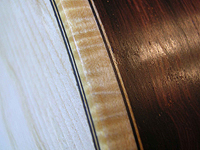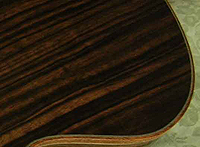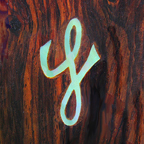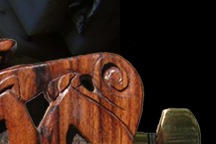        |

|
2023 MATERIALS

Soundboard:
- Sitka spruce is the standard high-quality wood for steel strings. Used by default.
- Englemann spruce is often (but not necessarily) a little less stiff, which is a negative,. Englemann tends to be paler and to stay that way, while Sitka will darken more with exposure to sunlight.
- Adirondack (Red) spruce has the most highly desirable acoustic properties, but cosmetically nice pieces are hard to find and will add to the cost of the guitar.
- Western red cedar is dark and warm, both visually and tonally. It tends to be mellow, but it often has less “punch” or “headroom”, and usually highs are less brilliant than with the spruces. It can be a good choice for 12-string guitars, keeping the high G from being too shrill.
- Bearclaw is not a species, but a squiggly grain pattern sometimes found in Sitka and other spruces. It is almost always available and it’s simply a matter of taste. If desired, please request. If my cost of currently available specimens is high, I may be required to add $10 to your price. This varies; it’s not predictable until I place my order for materials.
Back and Sides:
- Mahogany is inexpensive and average-sounding. It can be thin sounding particularly in the bass. Pleasant, ringing highs are usual. Mahogany is a favorite of traditional folk artists. It runs from honey-gold to reddish-gold. Occasionally highly figured “quilted” mahogany is available, adding about $300 to the cost. Please inquire if interested.
- Indian rosewood has a solid, full-bodied sound across all octaves. It is currently the best value in cost-to-sound-quality. As such, it is my default back-and-sides wood. Specimens vary from chocolate browns to dark bronze to reddish-brown Better specimens have more color variety or more contrasting grain lines It is now grown sustainably on plantations.
- Koa is shades of honey-gold and highly figured specimens can often be found, with extreme depth and “chatoyance”. Cost varies with the degree of figure. Typically add $250 to $500 for the best of the best. Tonally I place it between mahogany and Indian Rosewood, although individual pieces can be exceptionally responsive.
- Madagascar rosewood has more twisting and high-contrast grain than Indian. Reddish-brown with almost black grain lines is a typical pattern. It is somewhat denser and is a second-best tonally to African Blackwood or Brazilian Rosewood. (italics are my own opinion, not universally held – LM)
- Macassar ebony has tonal qualities similar to Madagascar rosewood, sometimes with a bit less sustain. Its striping can be very dramatic, and varies from tan-background-with-dark-brown-stripes, to the other way around. It is heavy, which may be a factor for musicians who play standing for long sets. Add $350.
- African Blackwood has great sustain – this used to be the only wood for great woodwind instruments. It is now very difficult to find in sizes large enough for acoustic guitars. When available it adds $500-$600 to the cost.
- Brazilian rosewood is the Holy Grail of tonewoods. Its dramatic spider-web grain lines and long ringing sustain are the basis of its reputation. However it is an endangered species and for that reason I will not use it.

|

|
MATERIALS GALLERY

| Visit the Materials Gallery for photos and much more.

Curly maple bindings.


Indian (left) and Madagascar (right) rosewoods (unfinished).


Macassar ebony.

|
|





